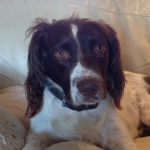News
Archive for March, 2016
March 2016 Wellness Screen Offer
by admin on March 2nd, 2016
Category: Special Offers, Tags:
February 2016 Neutering Offer
by admin on March 2nd, 2016
Category: Special Offers, Tags:
Pet of the Month – March 2016
by admin on March 2nd, 2016
Category: Pet of the Month, Tags:
Max developed marked swelling of opposite fore and hind limbs within hours of a muddy walk. Rather uniquely he had emphysema and oedema in his legs. Max was depressed and inappetant and the following day developed skin lesions and a low platelet count was detected on his routine bloods. He was sent to Anderson Moores Veterinary Specialists for fear he had contracted Alabama Rot and he was continued on aggressive fluid therapy, pentoxyphylline, a drug that helps stop vasculitis and general intensive care with frequent monitoring of his platelets and kidney parameters. His urine output was monitored. His feet were maintained in dressings and antibiotics were used for the secondary infections which occurred following the skin lesions and he had opiates for analgesia. Acute Kidney Injury typically develops in 1-10 days so this protocol was continued until he had passed the 10 day mark and then medications were continued until his skin lesions resolved.
Max was home in time for Christmas and we are delighted to report that he has continued to do well.
Laryngeal Paralysis in Dogs
by admin on March 2nd, 2016
Category: News, Tags:
What is laryngeal paralysis?
Laryngeal paralysis is a condition where the larynx (voice box) fails to open the vocal cords when breathing in. This makes it difficult to breathe, particularly when active, which results in a spectrum of symptoms from noisy breathing and reduced ability to exercise through to life threatening obstruction of breathing in severe cases. The condition is most commonly seen in middle aged to older dogs of medium to large breeds such as Labradors, Retrievers, Weimeraners and Great Danes. It is occasionally seen in young dogs of certain breeds and small breeds but it is uncommon in these cases.
What are the symptoms of laryngeal paralysis in dogs?
Common symptoms are:
- Increased noise when breathing. This is typically a raspy noise and loudest on breathing in. The noise increases with excitement and activity
- Reduced ability to exercise
- Collapse and sometimes cyanosis (blue lips and tongue)
- Change in bark
- Cough often retching in nature
Some patients may also have:
- Difficulty swallowing food and or water
- Weakness in the hind legs
Laryngeal paralysis is usually a progressive condition with a gradual onset and then worsening over months to years.
What causes laryngeal paralysis in dogs?
In the majority of dogs the condition results from a failure of the nerves which control the larynx to function normally. The exact cause of this nerve dysfunction is unknown but it is considered a condition of ageing. The laryngeal nerves are the first affected in the body because they are the longest, but some dogs will gradually develop symptoms of other nerve dysfunction including back leg weakness and swallowing problems.
In occasional cases the following can result in laryngeal paralysis: trauma to the neck, nerve damage during surgery in the neck, tumours of the neck and chest, poorly controlled under-active thyroid, specific neurological conditions of the nerves.
How is laryngeal paralysis confirmed?
The typical symptoms and breed of dog are often highly suggestive of laryngeal paralysis; however examination of the larynx under a light anaesthetic is required to confirm the diagnosis. At the same time blood tests to check for other diseases and a chest x ray to rule out complicating factors such as tumours and pneumonia are performed.
How is laryngeal paralysis treated?
Laryngeal paralysis cannot be treated to great effect with medication and is best treated with surgery. Symptoms can be reduced by using a harness and not exposing the animal to hot and humid conditions. However care must be taken as these patients can suddenly deteriorate and develop life threatening obstruction to breathing. This deterioration can sometimes be sudden and without warning.
Surgery provides a highly effective treatment for laryngeal paralysis. The procedure performed is known as a ‘laryngeal tieback’ or an ‘arytenoid lateralisation’. This surgery permanently holds one of the vocal folds in an open position, making it easier to breathe. The outcome with this surgery is very good with 90-95% of dogs having significantly improved ability to breathe and exercise. The surgery also removes the risk of life threatening airway obstruction. This is a technically demanding surgery and should only be performed by a surgeon experienced in the procedure.
Minor complications of surgery include:
- Seroma formation (tissue fluid accumulation at the surgical site)
- Increased coughing and gagging often associated with eating and drinking
Serious complications are uncommon but occur in approximately 5-10% of cases. These include:
- Airway swelling and obstruction
- Suture (stitch) failure or cartilage fracture resulting in failure of the surgery
- Aspiration pneumonia (inhaling food or fluid into the lungs resulting in serious lung infection)
Aspiration pneumonia is a lifelong risk following surgery. Certain patients are at higher risk of this complication, particularly those with difficulty swallowing before surgery. If identified as high risk, proceeding with surgery should be carefully considered in these patients. If identified early, pneumonia can be treated successfully in most patients with antibiotics. However it can prove fatal in up to 20% of cases. Early signs are dullness and loss of appetite, quickly progressing to rapid breathing and a cough.
How do I manage my pet after surgery?
- Use a harness and never use neck collars for restraint or exercise
- Take care in hot humid conditions. Even following surgery these patients cannot cope normally with these conditions
- Feed firm tinned food to reduce the risk of aspiration pneumonia
- Give only water to drink. Avoid gravies and milk which increase the risk of pneumonia
- Monitor carefully for the early signs of pneumonia





